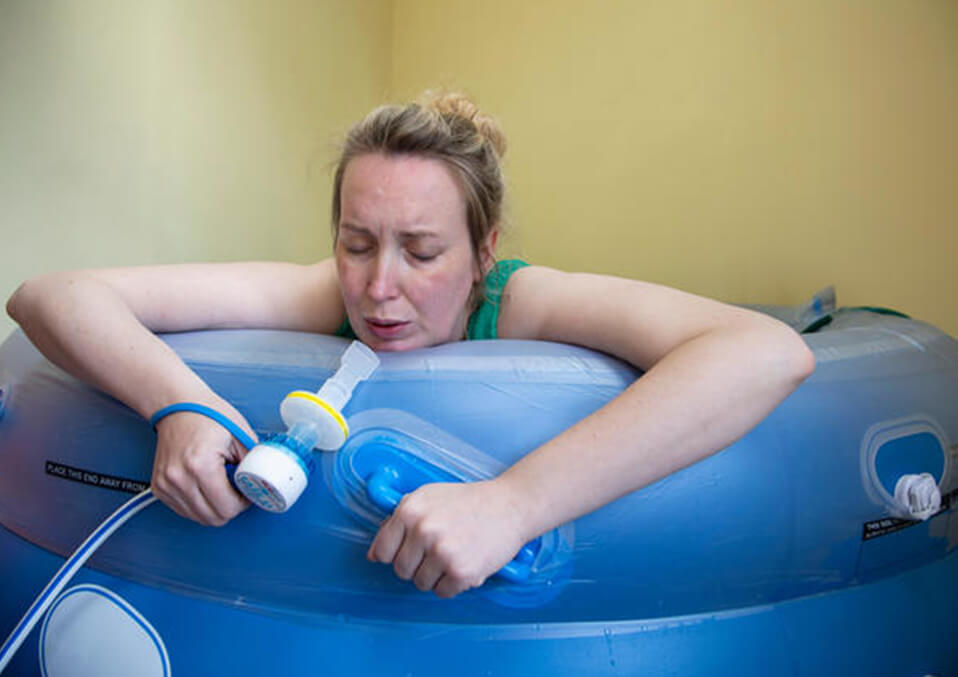Gas and air or also known as Entonox (laughing gas) is a commonly used method in relieving pain during labor. It is an odorless and colorless gas that is made of an equal amount of nitrous oxide and oxygen.
What gas and air do, is that it reduces the severity of the pain during labor by blocking it out. This method is easy to use and you can control the amount, that’s why many prefer this method.
During labor, you are going to be offered Entonox. Gas and air methods have easy access to hospitals because hospitals have a central supply system that frequently pumps gas and air. If in case you are going to give birth in a birth center or at home, where there is normally no central supply system, you can ask your midwife to provide gas and air in a portable cylinder.

Entonox is taken in through a mouthpiece or mask that you need to hold yourself. Each dose of Entonox takes about 20 seconds to become to start working. You need to take slow and deep breathes.
When properly used and under medical supervision, gas and air pain relief methods found to have no harmful side effects to you and your baby. But, you may feel sick and light-headed. In some cases, some mothers feel drowsy or unable to concentrate.
To know about the pros and cons of gas and air method, first, here are the pros:
- Safe for the baby and for you
- Your baby doesn’t need extra monitoring when you are using it
- It is widely available
- It can establish a good pattern in your breathing
- You can control the amount you take
- It is fast-acting
- It doesn’t stay long in your system
- It can be used at home or the birthing pool

And now, here are the cons:
- The relief in pain is mild
- It can make you feel drowsy, light-headed and sick
- It can make the mouth feel dry
- Having the mask or mouthpiece can sometimes hinder you from moving around a maybe find a comfortable position
- It can cause muscle cramps and spasms in your wrist or joints
It takes about 30 seconds of breathing the Entonox to enter your bloodstream so you need to inhale and exhale deeply for at least 1 minute before you can feel the effect of it in your body. You need to practice for the timing as well. Take in the gas and air as soon as you feel the contraction. If you wait when it gets hurt and then start taking a breath, you might end up feeling the pain relief in between contractions. So you need to get the timing, you need to take in seconds before you will have your contractions.

Throughout your whole labor process, you can use the gas and air method. You can use the Etonox or air and gas method during the full swing of your labor. Since Etonox can make your mouth very dry, you can also use lip balm or sips water in between contractions so that you will keep your mouth moist. Although the gas and air method are very popular and commonly used widely, it is not for everyone. It may not be enough for you to ease the pain. If you find that this method is very mild in easing the pain, you can try a different method of pain relief.
You may also find it easier to focus on pushing without gas and air on the second stage of your labor. You can also ask your midwife to swap to a mouthpiece because it is an easier way instead of a rubber mask which can make you feel queasy.
It will depend finally depend on you if you will use the gas and air method in relieving the pain during labor. You can weigh in the pros and cons and ask your doctor or midwife about it because they can give you medical advice on what’s better. We hope that this article helps you and you will have safe and less painful labor.
Read also:
- How Long Does Childbirth take place?
- Postpartum Survival Kit: Everything You Need to Minimize Your Pain
- 3 Tips on How to Recover Physically and Emotionally from Childbirth


